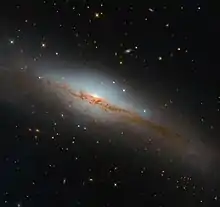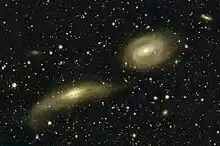| NGC 3749 | |
|---|---|
 NGC 3749 taken by Hubble Space Telescope.[1] | |
| Observation data (J2000[2] epoch) | |
| Constellation | Centaurus |
| Right ascension | 11h 35m 53.203s[2] |
| Declination | −37° 59′ 50.39″[2] |
| Redshift | 0.009272[2] |
| Heliocentric radial velocity | 2766.7km/s[2] |
| Distance | 130.52 Mly |
| Apparent magnitude (B) | 13.22[2] |
| Characteristics | |
| Type | Sa[2] |
| Other designations | |
| AM 1133-374, 6dFGS gJ113553.2-375951, ESO 320-8, ESO-LV 320-0080, HIPASS J1135-38, IRAS 11333-3743, IRAS F11334-3743, LEDA 35861, 2MASX J11355320-3759503, MCG-06-26-002, NVSS J113553-375951, PMN J1135-3800, PSCz Q11333-3743, RR95 198b, SGC 113325-3743.2, SUMSS J113553-375949, [CHM2007] HDC 658 J113553.20-3759503, [CHM2007] LDC 916 J113553.20-3759503[2] | |
NGC 3749 is a spiral galaxy located in the constellation of Centaurus at an approximate distance of 130.52 million light-years. NGC 3749 was discovered in 1835 by John Herschel.

NGC 3749 (left) and NGC 3742 (right) with the legacy surveys
References
External links
This article is issued from Wikipedia. The text is licensed under Creative Commons - Attribution - Sharealike. Additional terms may apply for the media files.